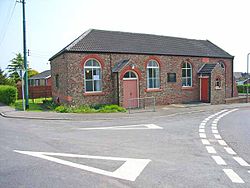Carlton, County Durham
| Carlton | |
| County Durham | |
|---|---|
 Carlton Methodist Church | |
| Location | |
| Grid reference: | NZ396218 |
| Location: | 54°35’28"N, 1°23’17"W |
| Data | |
| Population: | 726 (2011) |
| Post town: | Stockton-On-Tees |
| Postcode: | TS21 |
| Local Government | |
| Council: | Stockton-on-Tees |
| Parliamentary constituency: |
Stockton North |
Carlton is a village in County Durham, a few miles north-west of Stockton-on-Tees, and close by the village of Redmarshall.
The population of the civil parish taken at the 2011 census was 726.
History
Although subject to much new building in the past decade, the village still retains its mediæval layout, with houses facing each other across the main street, and with strips of land in front and behind. This layout had been identified as Norman, probably dating to the rebuilding of the village after William's harrying of the North.
The origin of the village of Carlton lies in the remote past, the pattern of the village was probably determined in the 11th or 12th century when estate re-organisation was commenced.

It is part of the ecclesiastical parish of Redmarshall which came under the auspices of the Bishop of Durham, and is situated north of the River Tees, about five miles to the west of Stockton-on-Tees, and until boundary re-organisation in 1974 was part of the County of Durham. It is 160 feet. above sea level, and was essentially a small agricultural village, the farmhouses and cottages built on either side of the main village street, probably an old drovers road, with a slow flowing stream running alongside the south of the settlement.
In 1200 AD, Bishop Pudsey of Durham caused a survey (the earliest record) to be made of all his possessions, this included Carlton, in which there were 23 farmers, a miller, and that William, son of Orm of Carlton, had to come to the great chase of the Lord Bishop with one greyhound whenever required. Towards the end of the 14th century there were 124 residents and at that time tenants had a common bakehouse, the lease being two shillings paid to the Bishop.
A railway station was built in about 1850, allowing the village to become a centre of industry, with goods trains, chemical works, coal depot and passenger trains. Houses and cottages were built for the workers, many of whom were housed in the village, this increased the population considerably at this time. Nevertheless, until piped water was installed in about 1895, the only water supply was from the village pump, situated in the centre of the village, although the village pump was still in general use many years later.
The first post office to be established was in 1933, when a room in a local cottage was converted for this use. The post office is now located in Carlton Village Stores. The arrival of the public telephone was much later.
Before the War there were many natural landmarks, which have now disappeared. There were well used footpaths around the village, about five duck ponds, orchards, trees and hedgerows. Progress meant that roads had to be widened and old property demolished, but village greens are still very pleasantly established, lately enhanced by bulbs planted by residents and regularly maintained by the Stockton Borough Council.
Services are held each Sunday in the Methodist Chapel, built in 1871, which stands in a prominent position at the east end of the village at the junction of the roads leading to Stockton and Thorpe Thewles.
About the village
The village public house 'The Smiths Arms', stands well in the centre of the village built in about 1900 (by Irish labourers lodged in the village) to replace an ancient inn nearby. Previously the South Durham Hunt used to partake of the 'Stirrup Cup' and meet here twice in the season. The Blacksmiths Shop, now the restaurant, situated next to the bar was a centre of activity in the village, gossip was exchanged, and horses shoed.
The village has a sports field with children's play area, a village green, Women's Institute hall, a chapel and a post office.
Outside links
| ("Wikimedia Commons" has material about Carlton, County Durham) |